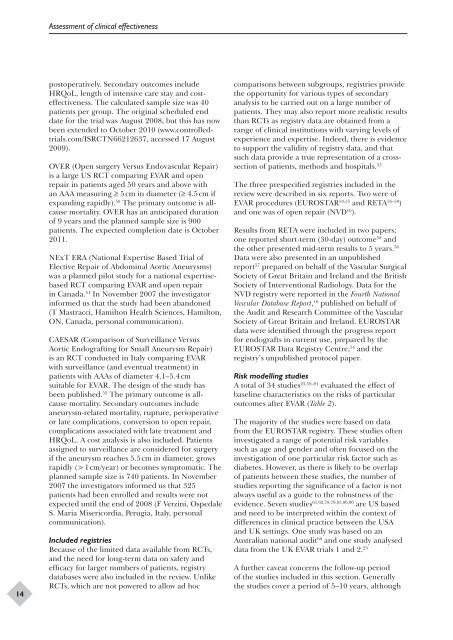Endovascular stents for abdominal aortic aneurysms: a systematic ...
Endovascular stents for abdominal aortic aneurysms: a systematic ...
Endovascular stents for abdominal aortic aneurysms: a systematic ...
Create successful ePaper yourself
Turn your PDF publications into a flip-book with our unique Google optimized e-Paper software.
Assessment of clinical effectiveness14postoperatively. Secondary outcomes includeHRQoL, length of intensive care stay and costeffectiveness.The calculated sample size was 40patients per group. The original scheduled enddate <strong>for</strong> the trial was August 2008, but this has nowbeen extended to October 2010 (www.controlledtrials.com/ISRCTN66212637,accessed 17 August2009).OVER (Open surgery Versus <strong>Endovascular</strong> Repair)is a large US RCT comparing EVAR and openrepair in patients aged 50 years and above withan AAA measuring ≥ 5 cm in diameter (≥ 4.5 cm ifexpanding rapidly). 50 The primary outcome is allcausemortality. OVER has an anticipated durationof 9 years and the planned sample size is 900patients. The expected completion date is October2011.NExT ERA (National Expertise Based Trial ofElective Repair of Abdominal Aortic Aneurysms)was a planned pilot study <strong>for</strong> a national expertisebasedRCT comparing EVAR and open repairin Canada. 51 In November 2007 the investigatorin<strong>for</strong>med us that the study had been abandoned .(T Mastracci, Hamilton Health Sciences, Hamilton,ON, Canada, personal communication).CAESAR (Comparison of Surveillance VersusAortic Endografting <strong>for</strong> Small Aneurysm Repair)is an RCT conducted in Italy comparing EVARwith surveillance (and eventual treatment) inpatients with AAAs of diameter 4.1–5.4 cmsuitable <strong>for</strong> EVAR. The design of the study hasbeen published. 52 The primary outcome is allcausemortality. Secondary outcomes includeaneurysm-related mortality, rupture, perioperativeor late complications, conversion to open repair,complications associated with late treatment andHRQoL. A cost analysis is also included. Patientsassigned to surveillance are considered <strong>for</strong> surgeryif the aneurysm reaches 5.5 cm in diameter, growsrapidly (> 1 cm/year) or becomes symptomatic. Theplanned sample size is 740 patients. In November2007 the investigators in<strong>for</strong>med us that 325patients had been enrolled and results were notexpected until the end of 2008 (F Verzini, OspedaleS. Maria Misericordia, Perugia, Italy, personalcommunication).Included registriesBecause of the limited data available from RCTs,and the need <strong>for</strong> long-term data on safety andefficacy <strong>for</strong> larger numbers of patients, registrydatabases were also included in the review. UnlikeRCTs, which are not powered to allow ad hoccomparisons between subgroups, registries providethe opportunity <strong>for</strong> various types of secondaryanalysis to be carried out on a large number ofpatients. They may also report more realistic resultsthan RCTs as registry data are obtained from arange of clinical institutions with varying levels ofexperience and expertise. Indeed, there is evidenceto support the validity of registry data, and thatsuch data provide a true representation of a crosssectionof patients, methods and hospitals. 53The three prespecified registries included in thereview were described in six reports. Two were ofEVAR procedures (EUROSTAR 54,55 and RETA 56–58 )and one was of open repair (NVD 16 ).Results from RETA were included in two papers;one reported short-term (30-day) outcome 58 andthe other presented mid-term results to 5 years. 56Data were also presented in an unpublishedreport 57 prepared on behalf of the Vascular SurgicalSociety of Great Britain and Ireland and the BritishSociety of Interventional Radiology. Data <strong>for</strong> theNVD registry were reported in the Fourth NationalVascular Database Report, 16 published on behalf ofthe Audit and Research Committee of the VascularSociety of Great Britain and Ireland. EUROSTARdata were identified through the progress report<strong>for</strong> endografts in current use, prepared by theEUROSTAR Data Registry Centre, 54 and theregistry’s unpublished protocol paper.Risk modelling studiesA total of 34 studies 23,59–91 evaluated the effect ofbaseline characteristics on the risks of particularoutcomes after EVAR (Table 2).The majority of the studies were based on datafrom the EUROSTAR registry. These studies ofteninvestigated a range of potential risk variablessuch as age and gender and often focused on theinvestigation of one particular risk factor such asdiabetes. However, as there is likely to be overlapof patients between these studies, the number ofstudies reporting the significance of a factor is notalways useful as a guide to the robustness of theevidence. Seven studies 61,62,78,79,85,86,90 are US basedand need to be interpreted within the context ofdifferences in clinical practice between the USAand UK settings. One study was based on anAustralian national audit 60 and one study analyseddata from the UK EVAR trials 1 and 2. 23A further caveat concerns the follow-up periodof the studies included in this section. Generallythe studies cover a period of 5–10 years, although
















